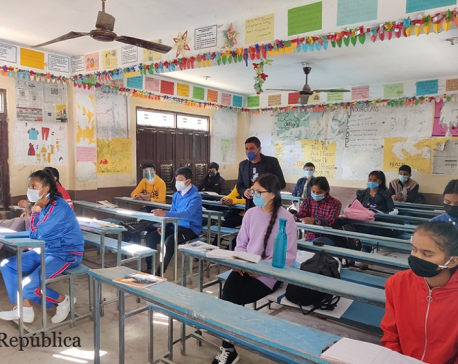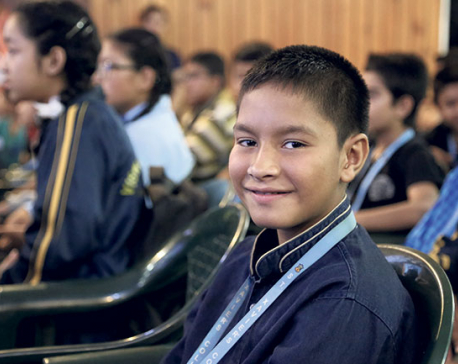
OR
Innovation in Education: Inclusion of Online Paradigm in Nepal
Published On: May 23, 2021 02:30 PM NPT By: Rohit Pandey


Rohit Pandey
Pandey is currently working as Chief Academic Officer for Islington College and ING Group Colleges, a group of academic institutions in Nepal.news@myrepublica.com
More from Author
Let’s embrace innovation in learning through online delivery, as driven by the crisis and need. It can certainly pave the way for inclusive online education in Nepal in the coming days.
The whole world is currently under the cold grip of the pandemic. While affecting almost every sector of business, commerce, research and development, it is also leaving a major impact on education. The fear of spread of the pandemic has resulted in complete stoppage of on-site learning activities keeping billions of students at home. While many of the developed and developing countries with robust digital infrastructure have the option to continue education through online platforms, there is a need for a thorough discussion on the feasibility of online education in Nepal.
Nepal has widely developed its access to the internet ever since it was first introduced in 1993 but it is still insufficient to incorporate the ONLINE medium as an inclusive option. We have been heavily relying on on-site teaching learning, but now we all need to accept the fact that ONLINE education is the new normal.
Invention and Innovation: The Context
‘Necessity is the mother of invention’. This is one of the most heard, said and popular proverbs in our everyday life. The phrase is mostly used when we need some creativity in our tasks. Its context was first coined in the Republic by Plato in around 380BC.
With ancient stories of Greek civilizations to the current day of moon missions, we have read and heard many stories of spectacular and life changing inventions. While some may argue, some inventions are accidental or unintended as the invention of microwave in 1946 by Percy Spencer and Pacemaker in 1956 by Wilson Greatbatch, most inventions come out of brilliant ideas and continuous effort. Accidental discoveries also were results of efforts towards invention. Invention of microwave by Percy while working on a radar-based project and invention of pacemaker by Wilson while building heart rhythm recording are some examples of it.
So, what exactly is innovation? Swiss Federal Institute of Intellectual Property defines invention as the use of technology to solve a specific problem. In general terms, innovations are new creations, which help us to find out the reality of the unknown.
Invention and Innovation: Comparison
In its purest sense, invention can be defined as the creation of a product or introduction of a process or a device for the first time. Innovation on the other hand occurs if someone improves on or makes a significant contribution to an existing product, process or service. Thomas Alva Edison is known as the Father of Invention of phonograph, the incandescent light bulb and the motion picture camera while Steve Jobs can be seen as a poster boy of innovation for his work in Apple for iPhone.
Innovation in Education: History of Distance Education
“In 1840, an English educator, Sir Isaac Pitman, taught shorthand by mail”. Pitman would mail text on postcards to students, and students would mail their assignments back to him. This can arguably be considered as the beginning of distance learning.
University of London is the first institution of higher education to embrace correspondence courses, offering degrees worldwide to people who were not able to study full-time on campus in 1858. Over 100 years later Nelson Mandela studied law as a University of London student while imprisoned on Robben Island.
Distance education started in Nepal by the College of Education in 1957 by launching a ‘Radio Education Program’ for teacher training and promoting adult education.
The initial medium of delivery for distance education included mail (Pitman), radio, television etc. The Internet is now the largest delivery medium of online education.
Embracing the Change: Online Classes in Nepal
Online learning is the application of distance learning. While distance learning only identifies geography as a factor of definition, online learning includes some form of interactivity in learning. Nepal Open University was opened as a result of Nepal Open University Act 2073 BS, embracing the change by providing higher education and training through open and distance mode. The university currently provides an open-source platform known as Moodle for teaching and learning purposes.
Nepal has its own issues and challenges regarding the current trend of distance education. The students in the remote areas of geographically remote places have always been deprived of access to education due to the lack of timely availability of printed books and the required number of schoolteachers.
The same pattern reflects in case of distance education. The geographical complexity, the affordability of basic home-based infrastructure like the internet and a computer system is a challenge that hinders distance learning for rural households and students. Accessibility of internet that is necessary to conduct distance classes has been a major hurdle for reachability in those areas.
Many universities and colleges like Harvard, Stanford etc currently provide online education also called “Massive Online Open Courses” (MOOC). It’s time, Nepal must adapt to the world education scenario by embracing the change of technology.
I have not seen discussion about - what happens if we do not continue education during the COVID-19 pandemic? What will be its future impact globally or at least on Nepal?
Crisis Triggered Online Learning: Delivery in Nepal
Ever since the outbreak of COVID-19, major countries of the world, including Nepal are going through the ‘shutdown’ as a measure to control the spread of the virus. This has caused a stoppage of on-site teaching and learning activities of all academic institutions in Nepal. The stoppage has resulted in education deprivation for almost a third of Nepal's student population.
The number of youths has been increasing in Nepal and so has been the number of students. Nepal is more inclined toward providing classroom-based teaching learning. According to the Ministry of Education, Nepal, there are about 75,000 academic institutions providing on-site teaching and learning service.
An immediate impact of the current lockdown is about half a million Secondary Education Examination (SEE) appearing students face undefined examination schedules. As this crisis looms, it is likely to hamper academic progression of even greater numbers of higher education students. As per the Census and Economic Information Center (CEIC) Data, there are approximately eight million students in Nepal who are currently staying at home as a result of the lockdown.
Some academic institutions providing higher secondary level education estimated the impact beforehand and started online delivery of classes before or immediately after the shutdown. Many schools and other academic institutions have joined the practice of online delivery. The largest university in Nepal, Tribhuvan University has started online classes from 26th of April 2020. This shift in paradigm is resultant of the current COVID crisis.
Way forward
There are various opinions regarding the process, policy, reach and effectiveness of online classes, however, the advent of this online teaching and learning journey is a commendable approach. Some experts may see online classes just as a remedy to overcome the current crisis, but it has certainly triggered the debate of online learning in Nepal. Online learning, if properly executed, can provide a platform providing access to many students and distributes equitable knowledge and skills.
The need for world class knowledge and skill is ever-demanding. We need to make our students capable of competing with students of the developed countries. Our country has issues of the internet and other resources which still are constraints to fully conduct online classes, but they can always be the medium to introduce innovation in delivery of education.
This initiative should not be just taken as a mere containment strategy to address the current COVID crisis. It should be incorporated by all stakeholders as an integral part of the education platform. Let’s embrace innovation in learning through online delivery, as driven by the crisis and need. It can certainly pave the way for inclusive online education in Nepal in the coming days.
Several higher education institutions around the world are experimenting with innovative approaches to teaching and learning in order to train future generations with skills for innovation. Harvard University launched a new Initiative for Learning and Teaching (HILT) in 2012 “to encourage pedagogical innovation and strengthen learning and teaching throughout the University”. It is time Nepal also started implementing innovative approaches in the field of education.
There have been encouraging initiatives to make contents online, but they are limited to fewer courses and reachability. Nepal currently lacks infrastructure to immediately implement innovative approaches of teaching learning for all curriculum and levels. It might not be possible to do it all at once, but we should attempt to incorporate innovative approaches of teaching and learning activities if we intended to give better education to all students and prepare them for competitiveness for opportunities in the world market. The innovations may be focused on effective instructional design and self-paced learning, accessible to the internet and access to rural geographic area and coverage of course based curriculum among many others.
Nepoleon Hill once said, “Don’t wait, the time will never be just right”. The current COVID scenario has put us in a challenging situation, and challenge brings innovation. Let’s start the innovation of education in Nepal from today for a better tomorrow.
(Pandey is currently working as Chief Academic Officer for Islington College and ING Group Colleges, a group of academic institutions in Nepal.)
You May Like This

Students are happy to return to school after a gap of nine months
MYAGDI, Nov 30: Anushka Bhattachan, a sixth grader at Beni Secondary School, met her friends Asima KC and Roshna Chhahari... Read More...

Let education continue
Government must ensure that no student will have to lose their academic year due to the pandemic. Every student should... Read More...

Overcoming Covid-19 pandemic
The Covid-19 outbreak has affected people across the globe, sparing no one and no sector. In Nepal, it has taken... Read More...







Just In
- NRB to provide collateral-free loans to foreign employment seekers
- NEB to publish Grade 12 results next week
- Body handover begins; Relatives remain dissatisfied with insurance, compensation amount
- NC defers its plan to join Koshi govt
- NRB to review microfinance loan interest rate
- 134 dead in floods and landslides since onset of monsoon this year
- Mahakali Irrigation Project sees only 22 percent physical progress in 18 years
- Singapore now holds world's most powerful passport; Nepal stays at 98th











Leave A Comment